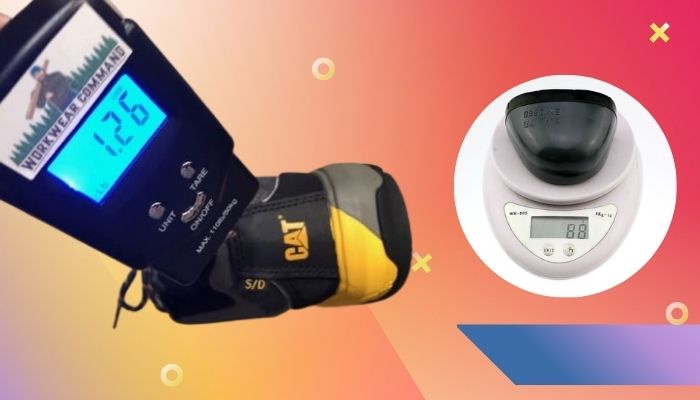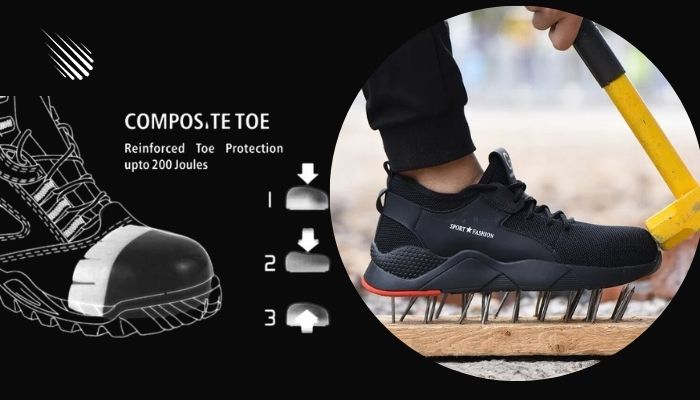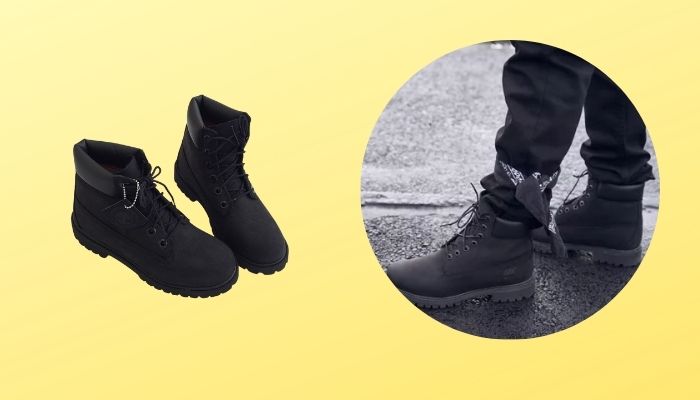Safety boots with composite toes are believed to be among the best. So, are composite toes truly adequate for protection, and if so, how much weight can they hold?
Too many questions, right? No worries, this article has all your answers.
After thorough research, I have shared how much load a composite toe can withstand, as well as answered a slew of other frequently asked questions about the composite toe.

So, make sure to read the article till the end.
How Much Weight Can Composite Toe Hold?
Composite toe can hold weight from 1.1 metric tons to 3.5 tons. Composite toes are often light, yet they are just as sturdy as steel toes. When a truck carrying 4-4.5 tons drives over the composite toe, it does not bend, keeping your toes safe.
Composite toe boots are usually worn by people who work in risky areas with high chances of injuring the feet. Keeping this in mind, composite toe boots are particularly built to withstand large impacts.
A pair of composite toe boots weigh between 700g to 1.8kg, which is very lightweight compared to other safety boots.
And many people have the misconception that as the composite toe boots weigh lighter, they aren’t sturdy enough to handle hard blows.
But let me bust out the myth!
Composite toe boots are said to be the new steel toe boots. Why?
Because the 700g-1.8kg composite toe boot can sustain a weight of 4.5 tons, which is something that most so-called safety boots can’t.
Check out our separate post: Can Composite Toe Boots Be Stretched.
What Is Composite Toe Made Of?
Composite toe boots are safety boots with toes constructed of non-metallic materials such as Kevlar, plastic, fiberglass, and carbon fiber.
Composite toe boots are lightweight and breathable, reducing foot fatigue and allowing you to wander around without interrupting your work.
There is no cold conduction because there is no metal in any part of the boots, keeping the feet warm no matter how cold the weather is.
Composite toe boots are not only ideal for cold weather but may also be worn in warmer weather.
The boots don’t conduct heat because they don’t contain any metal, so your feet stay cool and fresh. So you can wear composite toe boots in the rain or in the shine.

Not to mention that composite toe boots are pretty comfy to wear due to their design and material selections.
Their toe box is wider, allowing you to wiggle your toes. Anti-fatigue technology keeps the feet comfortable for longer durations.
Also read, Composite Toe Vs Steel Toe Boots.
Kevlar, fiberglass, carbon fiber, and plastic are non-metallic materials that offer the foot a softer feel.
Are Composite Toe Boots OSHA Approved?
Yes, good-quality composite toe boots are OSHA-approved. Composite toe boots are composed of non-metallic materials and do not carry electricity. They are also slip-resistant and puncture-resistant, satisfying OSHA requirements and making them perfect safety boots.
What actually OSHA is?
OSHA stands for Occupational Safety and Health Administration.
People who work on construction sites or in hazardous environments are not permitted to wear regular shoes or sandals to work. They must wear a specific sort of footwear that complies with OSHA requirements.
OSHA requires safety boots to be slip-resistant and puncture-resistant. Furthermore, the safety boots must be strong enough to resist heavier impacts and protect the feet from falling heavy objects.
OSHA mandates the workers to wear the special footwear to their work for feet protection, and if the employer fails to supply OSHA-compliant footwear or if the workers do not wear it, they must pay a fine.
Follow our guide to know Do Composite Toe Boots Get Cold.
How Strong Is Composite Toe?
Composite toes are made of non-metallic components that are exceptionally strong and durable on their own; when these materials are combined, the final result is a stronger composite toe.
Furthermore, an impact and compression test must be performed to determine if a pair of boots is sturdy or not.
If the boots pass the testing, it implies they meet OSHA or ASTM standards and are therefore approved as safety footwear.

Heavy objects are dropped on the boots in an impact test to see how well they can withstand the force.
Similarly, heavy objects roll over the boots in the compression test, and their effect is noted.
Fortunately, the composite toe passed both the impact and compression tests. Not only that, but an experiment revealed that a composite toe could endure over 200J of energy without dents or breaks on the toe cap.
Do check our latest post on What Does Shoe Width Letters Mean.
Is Composite Toe Stronger Than Steel Toe?
No, the composite toe is not stronger than a steel toe. Composite toes are strong but not strong enough compared to steel toes. Steel toe can withstand a higher impact than the composite toe because of the different materials used in both toes.
Both composite and steel pass the impact and compression test.
However, the composite toe can only survive one impact before cracking, whereas the steel toe can withstand several impacts without cracking or denting the toe cap.
Steel toe is completely made up of metal, whereas composite toe is entirely built of nonmetals. The addition of a metal toe cap increases the weight and strength of the steel toe boots.
Several tests demonstrate that the composite toe can sustain an impact of up to 200J, whereas the steel toe cap can endure an impact of up to 1133kgs.
As a result, the steel toe is unquestionably the obvious winner in terms of sturdiness.
You may also like Yeezy 350 Tight On Toes.
What Are The Benefits Of Composite Toe?
Composite toes are well-known for providing not just excellent foot protection but also a number of other advantages.
Here are the benefits of composite toe:
- Composite toes are lightweight, but they are just as strong and long-lasting as steel toes.
- Composite toes are OSHA-approved and meet the same safety standard as steel toes.
- The light composite toe decreases foot strain and allows you to stay in the boots for longer durations.
- Because there are no traces of metal in composite toes, they can simply pass through metal detectors.
- Since there is no metal in composite toes, they are poor at conducting cold; therefore, the feet stay warm even as the outside temperature drops.
- The composite toes are breathable, which keeps the feet fresh and makes them comfortable to wear for long periods.
- Composite toes do not conduct electricity, so the feet remain safe from electrical hazards.
- The composite toe has a wider toe box that lets the toes wiggle.
Conclusion
If your job requires you to wear safety boots that too should meet the OSHA standards, then without a doubt, go for the composite toe boots.
The composite toe boots will not only protect your feet from unknown working hazards, but the lightweight structure will also keep your feet tireless without compromising your work time.
However, make sure to invest in high-quality composite toe boots that are OSHA or ANSI certified. Because there are various types of composite toe boots, not all of them are OSHA authorized and therefore cannot give the best foot protection.
I hope you were able to find all of your answers in this article. If you have any questions on this topic, please leave them in the comment box.
Until then, bye!




